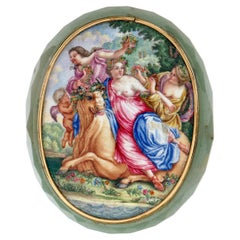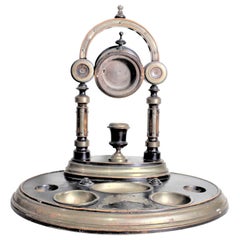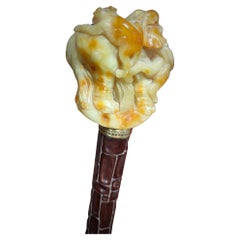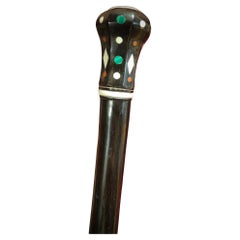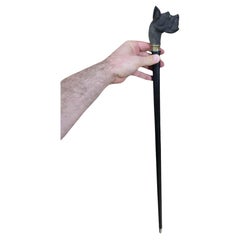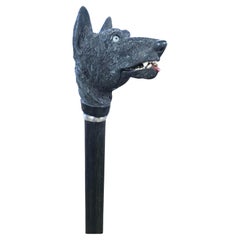Wood Collectible Jewelry
to
3
43
20
69
15
5
3
2
1
1
1
23
45
23
7
14
2
1
1
7
1
304,955
1,473
642
408
328
44
24
8
7
7
69
69
69
2
1
1
1
1
Material: Wood
Jewel pietradura walking stick depicting the rape of Europa, France 1870.
Located in Milan, IT
Walking Stick knob made out of green quartz semi-precious stone, oval enamel miniature painted on copper, depicting the rape of Europa and the bull. 18...
Category
Late 19th Century French Antique Wood Collectible Jewelry
Materials
Quartz, Metal, Gold
Antique English Wood & Brass Dresser Top Pocket Watch Stand & Vide Poche
Located in Hamilton, Ontario
This large wooden dresser top pocket watch stand and vide poche is unmarked, but believed to have been made in England in approximately 1890 in th...
Category
Late 19th Century English Victorian Antique Wood Collectible Jewelry
Materials
Brass
Cane In Baltic Amber XIX Century
Located in Madrid, ES
Cane In Baltic Amber XIX Century
ELEGANT GENTLEMEN'S CANE MADE IN AMBRAR AND THE WHIP IN EXOTIC GUAYANA WOOD END OF THE XIX CENTURY EXCELLENT CONDITION MEASURES 92 CM HIGH
Category
1880s Antique Wood Collectible Jewelry
Materials
Wood
$2,032 Sale Price
20% Off
Ancient Masonic Cane With Semi-precious Stones
Located in Madrid, ES
Ancient Masonic Cane With Semi-precious Stones
ANCIENT MASONIC CANE WITH SEMI-PRECIOUS STONES ELEGANT MASONIC CANE OF THE XIX CENTURY MADE IN EBONY AND...
Category
1890s Antique Wood Collectible Jewelry
Materials
Wood
$1,417 Sale Price
20% Off
Elegant 19th Century Ebony Cane
Located in Madrid, ES
Elevate your collection with this elegant 19th-century ebony cane. Expertly carved from rich ebony wood, this cane features a distinctive handle depicting a dog with an open mouth, s...
Category
1880s Antique Wood Collectible Jewelry
Materials
Wood
Elegant 19th Century Ebony Cane
Located in Madrid, ES
Elevate your collection with this elegant 19th-century ebony cane. Expertly carved from rich ebony wood, this cane features a distinctive handle depicting a dog with an open mouth, s...
Category
1880s Antique Wood Collectible Jewelry
Materials
Wood
Jeweler Box in Marquetry of Different Woods and Applications, circa 1930
Located in Saint-Ouen, FR
Jeweler box in marquetry of different woods and applications.
Artdeco period.
circa 1930.
Category
1930s French Vintage Wood Collectible Jewelry
Materials
Wood
Old Cane From The XIX Century
Located in Madrid, ES
Old Cane From The XIX Century
ANCIENT CANE OF THE XIX CENTURY ELEGANT CANE IN EBONY GOOD CONDITION MEASURES 92 CM HIGH
Category
1890s Antique Wood Collectible Jewelry
Materials
Wood
$850 Sale Price
20% Off
Early 20th Century Travelling Jewellers Precious Stone Samples, T.G.Woods
Located in Lowestoft, GB
A glazed sample case of precious stones, the collection of 12 gilt tins house a range of uncut stone samples all with their original hand penned labels. Among them is a rough diamond, Indian rubys...
Category
Early 20th Century British Edwardian Wood Collectible Jewelry
Materials
Tin
Recently Viewed
View AllMore Ways To Browse
Sleeping Cupid
Sovereign Case
Spanish Amphora
Spanish Colonial Shelf
Staffordshire Scottish
Standing Buddhas
Stone Buddha Head
Store Counter Island
Swedish Baroque Chest
Swedish Wooden Plates
Table Crucifix
Table Nuit
Tea Cosy
Teak Wood Elephants
Ten Drawer Dresser
Tennis Bronze
Terra Cotta Plate
Terracotta Vase Floor
